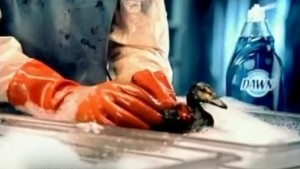When you buy dish soap, you probably think that you are saving all those sea creatures, birds and animals affected by oil spills. After all, one dollar of every bottle bought goes directly to saving wildlife (as seen in the advertisement below).
This advertising campaign made Dawn a BILLION DOLLARS in revenue last year!!
What companies don’t tell you is that most dish soap contains a chemical ingredient called “triclosan” that is actually recognized by Envirionment Canada as toxic to animals. Specifically, they wrote that trichlosan has “a high inherent toxicity to a variety of aquatic organisms, such as algae, macrophytes, invertebrates, amphibians and fish.”
So what is Triclosan? “Triclosan (5-chloro-2-(2,4-dichlorophenoxy)phenol) is used as a material preservative and as an antimicrobial ingredient in a variety of consumer products to stop the growth of bacteria, fungi and mildew and to deodorize.” – Environment Canada.


